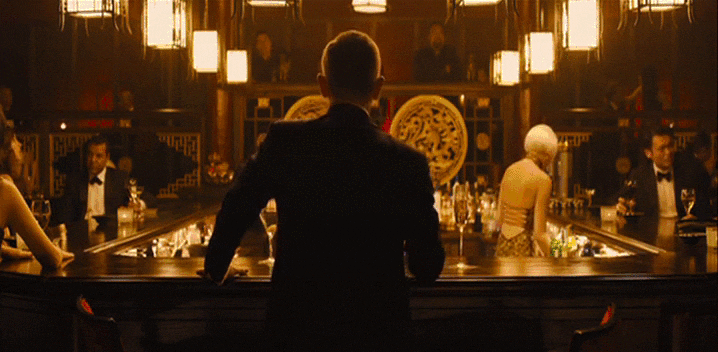Buenos Aires is a city where history and culture are woven into every corner, and nowhere is this more evident than in its iconic corner bars. These establishments are more than just places to enjoy a drink; they are living monuments to the city’s rich architectural heritage. Each bar tells a story through its unique design, blending European influences with Argentine tradition. This guide delves into the fascinating architecture of Buenos Aires’ most historic bars, exploring how they have become cultural landmarks over the decades.
The Legacy of Traditional Argentine Architecture
Buenos Aires’ corner bars, or bares notables, are a testament to the city’s architectural evolution. Many of these bars were established in the late 19th and early 20th centuries, a period when European immigrants brought their architectural styles to Argentina. These establishments were often designed to be more than just drinking spots—they were social hubs where locals gathered to share stories, discuss politics, and enjoy live music. The architecture of these bars reflects this role, combining practicality with ornate designs that make them stand out in the urban landscape.
Must-Visit Bars for Architecture Enthusiasts
Buenos Aires boasts a plethora of corner bars that are must-visit spots for anyone interested in architecture and history. Each of these bars offers a unique glimpse into the city’s past, showcasing a range of architectural styles that have become synonymous with Buenos Aires.
1. Café Tortoni
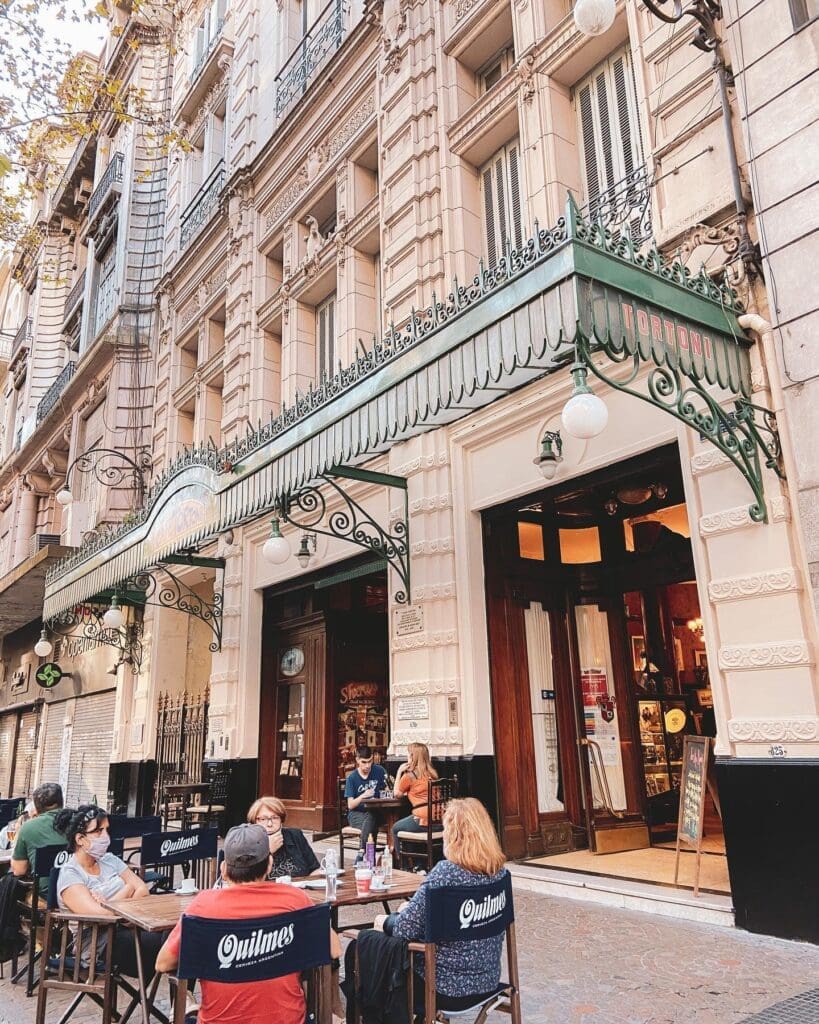
Established in 1858, Café Tortoni is perhaps the most famous of Buenos Aires’ historic bars. Located on Avenida de Mayo, this bar is a stunning example of the Art Nouveau style that was popular in Europe during the late 19th century. The interior is adorned with ornate woodwork, stained glass windows, and marble-topped tables, creating an atmosphere that harks back to the grandeur of the Belle Époque. Café Tortoni has been a cultural hub for over a century, attracting writers, artists, and intellectuals from around the world.
- Address: Av. de Mayo 825, Buenos Aires
- Website: www.cafetortoni.com.ar
2. Bar Británico
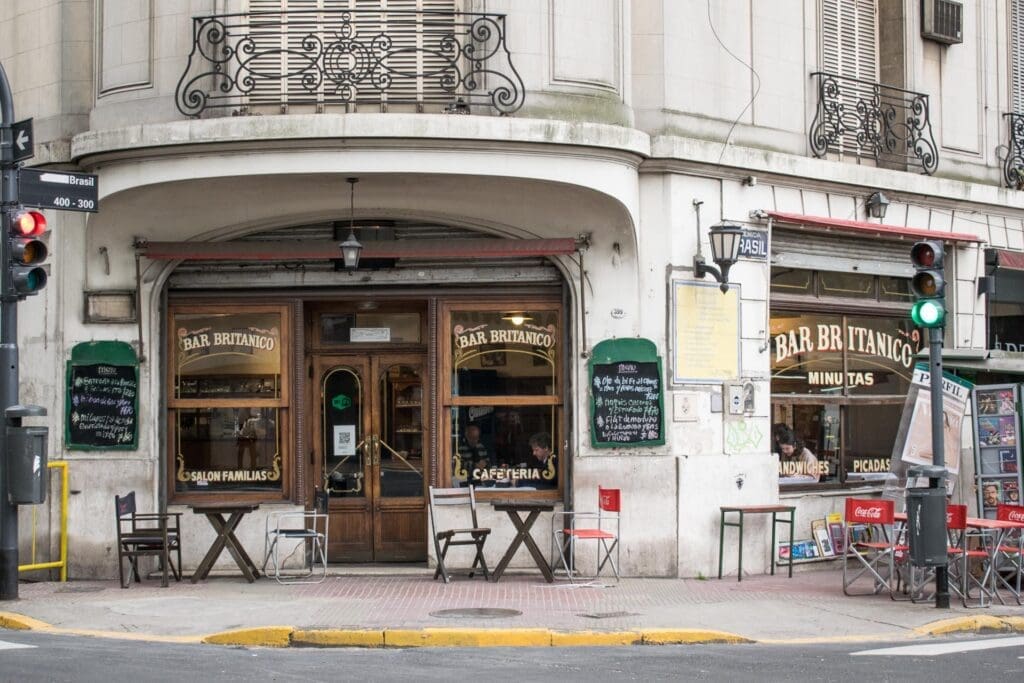
Located in the historic neighborhood of San Telmo, Bar Británico is a classic example of the Art Deco style that swept through Buenos Aires in the 1930s. The bar’s geometric shapes, curved lines, and bold colors reflect the modernist aesthetic of the era. Bar Británico has long been a favorite among locals and tourists alike, offering a nostalgic glimpse into Buenos Aires’ past.
- Address: Av. Brasil 399, Buenos Aires
- Website: www.facebook.com/barbritanico
3. El Federal
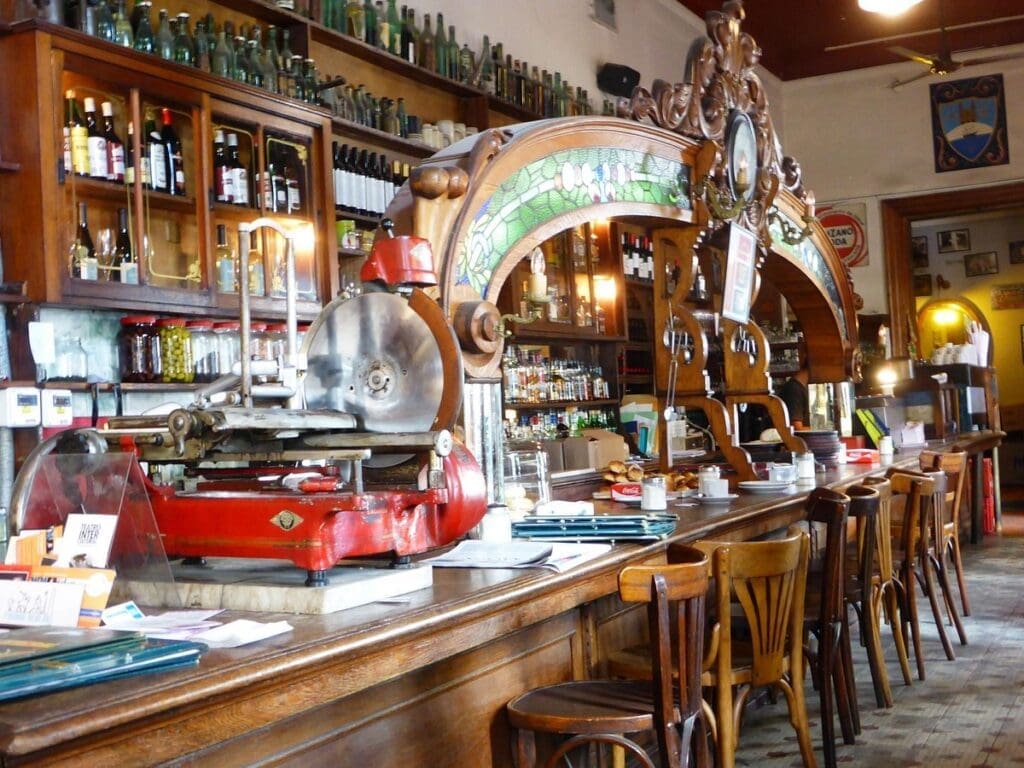
Another San Telmo gem, El Federal, dates back to 1864 and is one of the oldest bars in Buenos Aires. This bar is renowned for its preserved Art Nouveau decor, complete with stained glass windows, intricate woodwork, and period furnishings. The building itself is a historic landmark, offering visitors a unique opportunity to step back in time and experience the charm of 19th-century Buenos Aires.
- Address: Carlos Calvo 599, Buenos Aires
- Website: www.elfederalbar.com
4. La Biela
Situated in the upscale neighborhood of Recoleta, La Biela is an iconic bar known for its association with the city’s literary and artistic elite. The bar’s elegant neoclassical facade is complemented by its sophisticated interior, featuring leather armchairs, dark wood paneling, and photographs of famous patrons. La Biela has been a meeting place for writers, politicians, and celebrities for decades, making it a cultural institution in Buenos Aires.
- Address: Av. Pres. Manuel Quintana 596, Buenos Aires
- Website: www.labiela.com
5. Café de los Angelitos
Café de los Angelitos is another historic bar that has played a significant role in Buenos Aires’ cultural life. Located in the Balvanera neighborhood, this bar was established in 1890 and quickly became a favorite haunt of tango musicians and aficionados. The bar’s ornate facade and interior design reflect the opulence of the late 19th century, with intricate moldings, crystal chandeliers, and rich fabrics adorning the space. Today, Café de los Angelitos continues to be a popular venue for live tango performances, offering visitors a taste of Buenos Aires’ musical heritage.
- Address: Av. Rivadavia 2100, Buenos Aires
- Website: www.cafedelosangelitos.com
The Intersection of Architecture and Argentine Hospitality
The architecture of Buenos Aires’ corner bars is deeply intertwined with the city’s cultural identity. These bars are more than just places to drink—they are social hubs where people come together to share in the city’s vibrant culture. The architectural styles of these bars, whether Art Nouveau, Art Deco, or neoclassical, reflect the diverse influences that have shaped Buenos Aires over the years. Each bar offers a unique atmosphere that invites visitors to relax, socialize, and immerse themselves in the local culture.
Preserving Buenos Aires’ Architectural Heritage
The architectural heritage of Buenos Aires’ corner bars is a vital part of the city’s cultural landscape. Efforts to preserve these historic establishments are crucial to maintaining the city’s unique character. Many of these bars have been designated as cultural heritage sites, ensuring that their architectural and historical significance is protected for future generations. Restoration projects have been undertaken to maintain the original features of these bars, from their ornate facades to their richly decorated interiors.
Expanding the List: Other Notable Bars with Unique Architecture
While Café Tortoni, Bar Británico, El Federal, La Biela, and Café de los Angelitos are among the most famous, Buenos Aires is home to many other bars that boast unique architectural styles and historical significance. Here are a few more to consider:
6. Bar Sur
Located in San Telmo, Bar Sur is one of the oldest tango bars in Buenos Aires. The bar’s rustic facade and intimate interior create an atmosphere that transports visitors back to the early days of tango. Bar Sur has been a gathering place for tango enthusiasts since 1967, offering live performances in a setting that captures the essence of Buenos Aires’ musical heritage.
- Address: Estados Unidos 299, Buenos Aires
- Website: www.barsur.com.ar
7. La Perla
La Perla, situated in the neighborhood of Once, is another historic bar that has played a significant role in Buenos Aires’ cultural history. Established in the early 20th century, this bar is known for its association with the tango and the counterculture movements of the 1960s and 70s. The bar’s simple yet elegant design reflects its working-class roots, making it a popular spot for locals and tourists alike.
- Address: Av. Rivadavia 2800, Buenos Aires
- Website: No official website available
8. 36 Billares
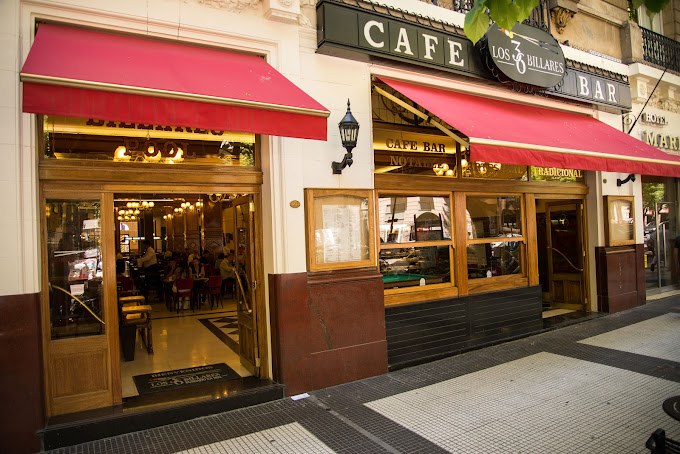
36 Billares, located on Avenida de Mayo, is a classic billiard hall that dates back to 1894. The bar’s neoclassical facade and grand interior are reminiscent of the grandeur of 19th-century Buenos Aires. 36 Billares has been a popular gathering place for billiard enthusiasts for over a century, offering a glimpse into the city’s leisure culture.
- Address: Av. de Mayo 1265, Buenos Aires
- Website: www.36billares.com.ar
While the previously mentioned bars are iconic, Buenos Aires has more hidden gems that boast unique architecture and rich histories. These bars add to the city’s vibrant tapestry of cultural and architectural heritage.
Florería Atlántico
Florería Atlántico is a unique establishment that combines a flower shop with a speakeasy-style bar. Located underground, this bar is a modern take on traditional Buenos Aires architecture, with industrial decor elements like exposed brick and metal accents. The bar’s atmosphere is both mysterious and welcoming, offering a different perspective on the city’s bar scene. This is a place where the past meets the present, blending traditional Argentine hospitality with contemporary design.
- Address: Arroyo 872, Buenos Aires
- Website: www.floreriaatlantico.com.ar
Bar La Puerto Rico
Another gem worth mentioning is Bar La Puerto Rico, a classic that has been serving the Buenos Aires community since 1887. Located in the heart of the city, this bar is a blend of Art Deco and Modernist influences. Its angular facade and minimalist interior set it apart from the more ornate styles of other historic bars. La Puerto Rico has long been a gathering place for artists, intellectuals, and locals who appreciate its rich history and cultural significance.
- Address: Av. Rivadavia 2070, Buenos Aires
- Website: No official website available
Café La Poesía
Café La Poesía is located in San Telmo and is a cozy bar that was originally founded in the 1980s by a group of poets and intellectuals. The bar’s decor reflects its literary roots, with walls adorned with books, typewriters, and photographs of famous writers. The interior features dark wood, vintage furniture, and a welcoming atmosphere that invites visitors to relax and soak in the history. It’s a bar where creativity and culture meet, making it a must-visit for those interested in Buenos Aires’ intellectual and artistic heritage.
- Address: Chile 502, Buenos Aires
- Website: www.cafelapoesia.com.ar
El Gato Negro, located on the bustling Avenida Corrientes, has been a staple of the city since 1927. Originally opened as a spice shop, this café-bar retains its exotic atmosphere with art deco design elements that reflect its origins. As you step inside, the aroma of eastern spices fills the air, blending seamlessly with the rich scent of coffee. El Gato Negro offers an immersive experience where architecture, history, and culture converge in the heart of Buenos Aires.
- Address: Av. Corrientes 1669, C1042 CABA, Argentina
- Website: https://www.cafegatonegro.com.ar/
In the quieter Boedo neighborhood, Café Margot stands as a testament to the enduring charm of early 20th-century Buenos Aires. Housed in a building from 1903, this café is less frequented by tourists, offering a more authentic glimpse into the city’s past. With its exposed brick walls, wooden cabinets, and classic tiled floors, Café Margot captures the essence of a bygone era, making it a favorite among locals seeking a traditional porteño experience.
- Address: Av. Boedo 857, C1233AAI CABA, Argentina
Another gem worth mentioning is Clásica y Moderna, a venue that marries literature, music, and dining in a setting that has been a cultural hub since 1938. This unique space, filled with bookshelves and reminiscent of European literary cafés, doubles as a jazz club, offering an eclectic mix of intellectual ambiance and live music. Clásica y Moderna is a haven for those who appreciate the finer things in life, where architecture and culture intersect in the most harmonious way.
- Address: Av. Callao 892, C1023 AAP, Buenos Aires, Argentina
- Website: https://www.clasicaymoderna.com.ar/
These additional bars, alongside the more famous ones already mentioned, provide a fuller picture of Buenos Aires’ vibrant cultural and architectural landscape. Each venue tells a unique story, offering visitors not just a place to enjoy a drink or a meal but an opportunity to step back in time and experience the rich history and artistic flair that define this incredible city.
Conclusion: A Journey Through Time and Architecture
Buenos Aires’ corner bars are more than just places to enjoy a drink—they are windows into the city’s rich architectural and cultural history. Each bar offers a unique experience, blending traditional Argentine hospitality with stunning architectural design. Whether you’re an architecture enthusiast, a history buff, or simply looking to soak up the local culture, exploring these iconic bars is a must-do when visiting Buenos Aires.
From the ornate Art Nouveau designs of Café Tortoni to the elegant neoclassical style of La Biela, these bars tell the story of Buenos Aires’ evolution over the past century. As you step into these historic establishments, you’ll not only enjoy a taste of Argentina’s vibrant culture but also a journey through the architectural styles that have shaped the city’s identity.
By preserving these architectural treasures, Buenos Aires ensures that future generations can continue to enjoy the unique charm and character of its historic corner bars. So, the next time you’re in Buenos Aires, take the time to visit these iconic establishments, and experience firsthand the intersection of architecture, history, and Argentine hospitality.




